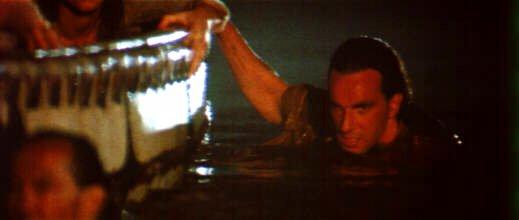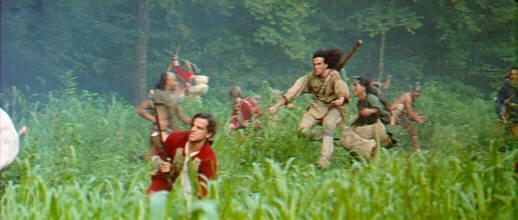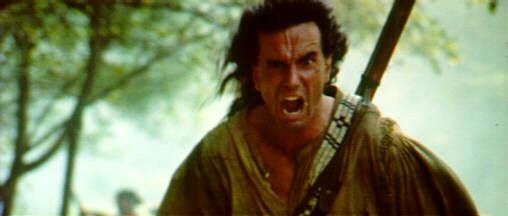MohicanLand Musical Musings: The Music of The Last of the Mohicans

Themes and Motifs
Many composers have historically used themes and motifs to add "meaning" to their music to help tell
stories and paint pictures. In fact, the
Oxford Companion to Music states that "Almost any piece of music will be found, on close examination, to be
developed out of some figure or figures, repeated––at different pitches, and perhaps with different intervals,
yet recognizably the same." (Oxford: 1938, 1995; pg. 661). In opera, themes and motifs are widely used to represent
people and/or events, so that when the audience hears a specific pattern of notes, they can know the person or event
being highlighted by that part of the music (e.g., when a character enters the stage, Puccini always played that
character's motif). The Last of the Mohicans is full of themes and motifs repeated at particular times and
events. (For the sake of simplicity, these Musings refer to a "motif" as just a few notes or 2-3 measure, and
a "theme" as many several measures, an extended passage.)
While most people would find it hard to argue
with easily recognizable motifs, what those motifs represent is entirely subjective.
Again, this is only one person's viewpoint. The motifs this LOTM fan has found are as follows.
- The Life Theme. This is essentially "The Gael". The first time we hear this motif is at night in the fort,
during a break in the battle. Among the wounded, dying, and dead, someone strikes up a fiddle
and a few people dance, bringing a bit of life to the bleak scene. In the midst of it all, Hawkeye and Cora have
their first kiss, clearly indicating that life DOES go on in spite of the death and destruction. The second time we
hear this theme is when Uncas is racing up the mountainside to save Alice's life, and he is fighting the most desperate
fight of his own young life. As Magua slaughters Uncas, and Uncas' life drains from his body, the music of "The Gael"
fades and ends, and we hear only the deep low beat of a drum as Alice contemplates and then ends her own life.
Finally, we hear it almost immediately again when
Chingachgook comes to his own full strength to revenge his beloved lost son. When Magua is dead,
the Life Theme again fades and Chingachgook reverts to his quiet and inward self.
- The Cora Motif. This is essentially three measures from the piece called "Cora",
but we hear it first during Duncan's
arrival at Albany when he is looking at the miniature painting of her, while riding in his carriage.
We hear it again during "Cora", when Duncan and Cora are meeting in Albany. The following
sound clip consists
first of the Cora motif in "Cora" and, after a brief pause, the same motif in "The British Arrival".
Press the Play button to play the sound bite.

- The Hawkeye and Cora Theme. This theme occurs four times in the
movie: during "The Kiss", during the scene in the surgery when Hawkeye says, "I'm looking at you
miss," within "Stockade", and a fourth time, only in the movie, during the credits. In the first
instance, the melody is played sweetly by the strings, and in the second case it is enhanced by a beautiful
counter-melody played by a gentle, breathy wood flute, probably native flute.
In the third case, in the stockade, it is played with great pathos by the English horn.
The following sound bite plays this theme first from "The Kiss" followed immediately by the same version in "Stockade".
Press the Play arrow to hear the sound bite. 
- The Mohican Theme. Both "Fort Battle" and "Massacre/Canoes" rely on a theme referred to
here as the Mohican Theme. Use of the Mohican Theme is very much timed to specific events in
both the Ambush, Fort Battle, and Massacre scenes (indicating how tightly the film editing and
cues can be tied to the music):
- During the ambush and rescue on the George Road,
the Mohican Theme coincides with and highlights the instant Chingachgook's war club bursts
through the bushes followed closely behind by Uncas and Hawkeye, coming to the rescue of the British.
 During the "Fort Battle", the Mohican Theme appears the first time we see Hawkeye and the Mohicans in the lake
pushing the canoe carrying the British. In this scene, the Mohican Theme reappears as they approach
the entrance to the fort, with Hawkeye holding Cora's arm and Uncas supporting Alice's
arm as they make their way up the incline.
During the "Fort Battle", the Mohican Theme appears the first time we see Hawkeye and the Mohicans in the lake
pushing the canoe carrying the British. In this scene, the Mohican Theme reappears as they approach
the entrance to the fort, with Hawkeye holding Cora's arm and Uncas supporting Alice's
arm as they make their way up the incline.
 During the massacre scene, the Mohican Theme appears
at the moment we first see Hawkeye racing through the fighting mob looking for the
Monro daughters (or at least Cora), while Uncas is not far behind, engaging one of the enemy.
This can be heard at 1:08-1:28 on the CD recording.
During the massacre scene, the Mohican Theme appears
at the moment we first see Hawkeye racing through the fighting mob looking for the
Monro daughters (or at least Cora), while Uncas is not far behind, engaging one of the enemy.
This can be heard at 1:08-1:28 on the CD recording.
 Shortly after, the Mohican Theme briefly appears again, for just a couple of measures, when Hawkeye
sees Cora on the verge of being knifed by a Huron and he begins to run towards her
(2:40-2:50 on the CD).
Shortly after, the Mohican Theme briefly appears again, for just a couple of measures, when Hawkeye
sees Cora on the verge of being knifed by a Huron and he begins to run towards her
(2:40-2:50 on the CD).
Given these examples, one might almost call this the Mohican Rescue Theme, as in each case, we hear it when
the Mohicans and Hawkeye are rescuing the British.
This theme is a vital and vibrant melody played by the
trumpets in both pieces, and is based heavily on the A-A section of the "Main Title",
in that it follows the same general note progression, but with a smoother, grander, more legato feel.
To compare the Mohican in both works, the following sound bite consists of the Mohican Theme
in "Fort Battle", in the key of A minor, and then the same theme in "Massacre/Canoes", in the key of D minor. In the
first case, the music appears to be set in 6/8 time, and in the second case it appears to be in 3/4 time,
so that in both cases the Mohican Theme is based on a count of three.
This and the fact that the keys of A minor and D minor are
complementary (the A is the dominant (5th) of the D minor, the key of the "Main Title") makes it possible
to use the one theme in two different settings while maintaining the same note structure in both settings.
Press the Play button to play the sound bite. 
The Primary Musical Pieces in LOTM
 Back to the beginning of MohicanLand Musical Musings Back to the beginning of MohicanLand Musical Musings
  

Copyright �1999 - 2001 by Sarah F. Melcher - ALL RIGHTS RESERVED
|